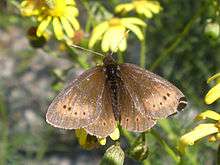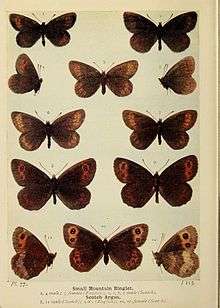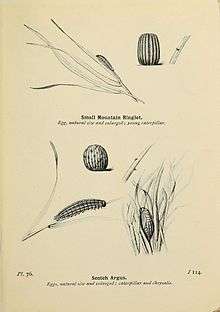Small mountain ringlet
| Small mountain ringlet | |
|---|---|
 | |
| (Canillo, Andorra) | |
| Scientific classification | |
| Kingdom: | Animalia |
| Phylum: | Arthropoda |
| Class: | Insecta |
| Order: | Lepidoptera |
| Family: | Nymphalidae |
| Genus: | Erebia |
| Species: | E. epiphron |
| Binomial name | |
| Erebia epiphron (Knoch, 1783)[1] | |
The small mountain ringlet or mountain ringlet (Erebia epiphron) is a butterfly of the Nymphalidae family. It is found in mountainous regions of southern and central Europe.[1]
Distribution
Mountain areas of Albania, Andorra, Austria, Great Britain, Czech Republic, France, Germany, Greece, Italy, Liechtenstein, Macedonia, Poland, Romania, Slovakia, Spain, Switzerland, Yugoslavia (Serbia, Kosovo, Voivodina, Montenegro, Bosnia and Herzegovina, Croatia).

Great Britain
It is Britain's only true alpine species of butterfly. The larva feeds on moor matgrass near bogs and springs and the nectar-feeding adult visits bilberry, tormentil and heath bedstraw.[2]
Life history
The pale cream eggs are laid singly, each female laying up to 70. The egg stage lasts 2 or 3 weeks.
The larva is green with a double dorsal and a single lateral white or yellowish line. The 3rd instar larvae hibernates in grass tussocks where they hibernate. They emerge in the spring and recommence feeding. Some larvae spend two years in this stage, the result of a late spring and short summer restricting growth. Recorded larval foodplants are Aira praecox (Czechoslovakia, Spain), Deschampsia cespitosa (Czechoslovakia), Festuca ovina (Spain), Nardus stricta (British Isles) and Poa annua (Spain)
The pupa is formed deep in grass tussocks, encased within a loose silk structure. The pupa stage lasts about 3 weeks.
The flight period is extremely short, a few weeks only, June–August depending on altitude.
Description

Description in South (1906).
Adult
Wingspan 16–22 millimetres (0.63–0.87 in). "The typical form of this butterfly, epiphron, Knock, has the tawny bands unbroken on the fore wings, and almost so on the hind wings; the black dots on the hind wings of the female are often pupilled with white, and more rarely this is so in the male also. It has been stated that specimens occur in Perthshire which exhibit these characters. All the British examples of the small mountain ringlet that I have seen are referable to the form known as cassiope, Fab. (Plate 77). The tawny, or orange, bands are rarely so entire on the fore wings as in epiphron, and are generally rather narrower; and that on the hind wing is broken up into three or four rings. The black dots are usually smaller and without white pupils. The female is somewhat larger and the bands or rings paler. Variation in the markings is extensive. The bands on the fore wings become less and less complete, until they are reduced to a series of mere rings around the black dots. The black dots decrease in size and in number until they, together with the tawny marking, entirely disappear, and a plain blackish-brown insect only remains. This extreme form has been named obsoleta, Tutt. The earliest rings to vanish seem to be the third on the fore wings and the first on the hind wings. Similar modifications occur on the under side also, but there may be aberration on the upper side of a specimen, and not, or at least not in the same way, on the under side."

Early stages
"The egg when first laid, is yellow, changing afterwards to fawn colour with darker markings, especially towards the top. It is laid in July on blades of grass. The larva hatches in about sixteen days. The young caterpillar, before hibernation in October, is greenish, with darker green and yellow lines. Head brownish. Feeds in July and after hibernation on various grasses, among which Poa annua, Festuca ovina, Aira praecox, and A. caespitosa have been specified as eaten by caterpillars in confinement. A distinct preference, however, has been shown for mat grass (Nardus strictus), and it has been suggested that this may be the natural food. The full-grown caterpillar appears to be undescribed. The chrysalis is described by Buckler as being "little more than three eighths of an inch in length, rather thick in proportion, being less dumpy in form than hyperanthtis, but more so than blandina [Erebia cethiops]. The colour of the back of the thorax and wing cases is a light green, rather glaucous; the abdomen a pale drab or dirty whitish; a dark brown dorsal streak is conspicuous on the thorax, and there is the faintest possible indication of its being continued as a stripe along the abdomen. The eye-, trunk-, antenna-, and leg-cases are margined with dark brown, and the wing nervures are indicated by the same colours."
Subspecies
- Erebia epiphron epiphron Harz Mountains
- Erebia epiphron aetheria Esper, 1805
- Erebia epiphron mackeri Fuchs, 1914 (synonym Erebia epiphron vögesiaca Goltz, 1914)
- Erebia epiphron mnemon Haworth, 1812 (synonym Erebia epiphron scotica Cooke, 1943;)
- Erebia epiphron orientpyreanica Eisner, 1946 (synonym Erebia epiphron fauveani) Pyrénées-Orientales
- Erebia epiphron pyreanica Herrich-Schläffer, 1851
- Erebia epiphron silasiana Meyer-Dür, 1852
- Erebia epiphron transylvanica Rebel, 1908
- Erebia epiphron retyezatensis Warren 1931
- Erebia epiphron roosi Arnscheid et Sterba
- Erebia epiphron orientalis or Erebia orientalis Bulgaria
- Erebia epiphron nelamus high altitude
Hybrid Erebia serotina epiphron × Erebia pronoe
References
- 1 2 van Swaay, C., Wynhoff, I., Verovnik, R., Wiemers, M., López Munguira, M., Maes, D., Sasic, M., Verstrael, T., Warren, M. & Settele, J. (2010). Erebia epiphron. In: IUCN 2008. IUCN Red List of Threatened Species. Retrieved 11 July 2012.
- ↑ "UK Butterflies - Mountain Ringlet - Erebia epiphron". Retrieved 11 July 2012.
External links
| Wikimedia Commons has media related to Erebia epiphron. |
